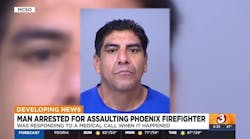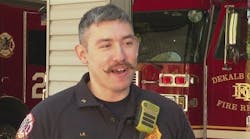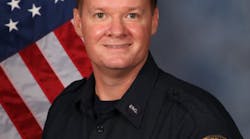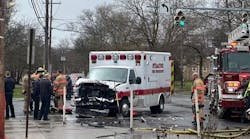While heroic firefighters lose their lives each year attempting the rescue of those trapped, many more of us lose our lives due to heart attacks and related medical emergencies. This month, a fire captain in Michigan responds, like any of us do regularly, to a house fire, but this time, the outcome is significantly different. Our appreciation to Captain Mark Burmeister of the Shelby-Benona Fire Department of Shelby, MI, for sharing his very personal story. We also thank Eric Bergman, a Physician Assistant-Certified (PA-C) and 14-year veteran of the fire service in Connecticut, and Dr. Raymond Basri, MD, FACP and deputy county fire coordinator in Orange County, NY, for their assistance and commentary.
The following account is by Captain Burmeister:
I'm sitting at my computer, wondering why I am writing my story for Firehouse® Magazine. Would anyone care what a 46-year-old captain from a small rural on-call fire department in western Michigan has to say? My story nearly ended on May 27, 2008, when I experienced a blockage in the left anterior descending artery of my heart, known in the medical field as a "widow maker" (I didn't tell my wife that until I was on the road to recovery).
It was a typical Tuesday afternoon. The weather was mild for the day after Memorial Day. I was just getting ready to eat dinner with my wife and 7-year- old daughter when my department received a page for a house fire with smoke and flames visible. On my way to the station, dispatch reported they had advised the homeowner to evacuate, but he was returning inside to save the family's belongings. That is when I requested an ambulance be sent to the scene. Chief Jack White arrived on scene, established command, called a working fire and began operations.
I arrived on scene in the second-in engine and was told to head to the second floor with my crew. The upstairs was heavily charged with smoke. We proceeded to use hydraulic ventilation to locate the fire until the roof could be vented. After exhausting our air supply, we retreated and reported to our squad for an air bottle change and reassignment. While waiting in staging, I felt a sharp pain in my chest like I had never felt before. As I removed my facepiece to tell Chief White I was done, the look in his eyes told me I looked as bad as I felt and was promptly sent to the waiting ambulance with absolutely no objection from me.
I knew the ambulance crew well because my full-time job is a paramedic/supervisor for the ambulance service. I was hooked up to the heart monitor. I had ST elevations in multiple leads and I was having a heart attack. The course of treatment began immediately in the back of that ambulance, continued at the local community hospital and didn't slow down until I had a stent (a small metal mesh tube used to keep the artery open) placed in my artery and was put in the ICU bed at a larger hospital 30 miles from home.
Back to why I writing this after one of my three-times-a-week rehabilitation sessions. I was reading stories on www.firefighterclosecalls.com and I sent in a copy of an article the local newspaper wrote about my ordeal. I received an e-mail from Chief Goldfeder asking me to write a more thorough letter with more details, my observations and comments. Here they are in the sincere hope this helps other firefighters.
The most notable thing that went right was the presence of an ALS ambulance on scene. This was not a standard in our area, at least not that early in the operation. I requested it because of the homeowner returning to the structure, not thinking it would save my life. Where we were operating it would have taken a minimum of eight minutes to get them on scene. I had ALS cardiac care within three minutes of onset of symptoms and was on the road to the hospital in 10.
From a firefighting standpoint, our system of automatic mutual aid assured we had enough help on scene or on the way to take over for me and the firefighters who came to my aid, allowing us to continue safe operations. A second ambulance was sent to replace the one transporting me and treated another firefighter for heat exhaustion.
This story actually began years ago, when I refused to eat the vegetables my mother put on my plate at dinnertime. I never changed my ways. I always thought the four main food groups were pizza, eggs, steak and hamburgers. Working on an ambulance, most of my meals were eaten while driving or in such a hurry I couldn't even taste it if I wanted to. Anyone who works in emergency services knows that when food comes through the vehicle window or is put on the table, you eat it now because you might not get a chance again. That and the lack of quality exercise lead to a recent diagnosis of Type 2 diabetes.
Because of this, I had started to change my ways, though not soon enough. I had the risk factors - my mother died at age 62 from a heart attack and several relatives on both sides of my family died too soon from heart disease; I had chronic high blood pressure, a lack of exercise, a poor diet and stress. The only major factor I don't have is smoking. I have never smoked, but I spent my childhood around secondhand cigarette smoke and most of my adulthood working on engines or smelling the exhaust and, of course, the gases associated with firefighting.
I have seen the way my heart attack has affected other people. How my chief and fellow firefighters and the medical people had to continue doing their jobs knowing one of their own was in trouble. How their wives, husbands, sons and daughters have taken more of an interest in what their firefighting loved ones eat and what exercise they get. How my wife has to spend extra time food shopping because of reading nutrition labels and too much more to mention.
The financial costs are still adding up. It has cost my department's insurance company over $30,000 in medical bills (there was no hesitation by the department or the insurance company in declaring this a line-of-duty injury), added to the cost to my full-time employer to fill my shifts and pay me for sick and vacation time that I won't have for future use.
Some positive results: the members of my department have started a campaign to gather exercise equipment from basements, garages and storage sheds to set up a fitness area in our station. The chief's daughter has started the groundwork to set up a countywide contest among departments patterned after the TV show "The Biggest Loser." We are working with our dispatch to make an ALS ambulance part of the automatic structure fire response.
Because of the expert and timely care I received, I intend to return to full duty by the end of July and to grow old with my wife and see my daughter grow up. With my new outlook on life, my jobs, and the health and safety of me and my brothers and sisters in the fire-EMS service, I intend to do whatever I need to ensure that next time and every time everyone goes home. My thanks to Fire Chief Jack White; Oceana County EMS Director Lance Corey; Crystal Clevenger, EMT-P; Kay Abeig, EMT-S; the entire staff of Oceana County EMS; the officers and members of Shelby-Benona Fire Department; the staff of the Lakeshore campus of Mercy Health Partners Emergency Room; and, of course, my wife, Mary, and my daughter, Katelyn.
Eric Bergman comments:
These comments are based on my research of current medical studies. Firefighters have one of the highest deaths rates from cardiovascular disease than any other occupation. Nearly half of all line-of-duty deaths are due to heart attacks annually and are the number-one cause of on-duty deaths in firefighters each year.
Firefighters have the greatest chance of having a heart attack during structural firefighting operations. This is most likely due to the intense physical demands of structural firefighting. Anyone who has put on bunker gear with self-contained breathing apparatus (SCBA) and performed interior operations at a structure fire knows how physically demanding firefighting is. Firefighters have a higher risk of having a fatal heart attack on the job than the rest of the public, probably due to this stress on the cardiovascular system.
Major cardiac risk factors increase the risk of having a heart attack. In firefighters, high blood pressure, high cholesterol, age greater than 45 and smoking increase the risk of having a heart attack. Age alone increases the risk of having a heart attack, but having other cardiac risk factors over this age significantly increases the risk of having a heart attack. Additionally, firefighters with diagnosed heart disease are at a higher risk of having a fatal heart attack. This cannot be stated clearly enough - if you have these risk factors, your chance of having a fatal heart attack on the job is higher than if you don't.
The good news is that deaths from heart attacks can be prevented. It has been shown that controlling blood pressure and cholesterol levels can reduce the risk of having a heart attack. Quitting smoking can also reduce the risk of having a heart attack. If your departments does not have established medical screening and wellness programs, tell your doctor that you want to reduce your risk of having a heart attack due to the increased risk as a firefighter.
The first step to controlling blood pressure and cholesterol levels is lifestyle changes. This includes a minimum of 30 minutes of aerobic exercise four times a week. Also recommended is following the American Heart Association Heart Healthy Diet (viewable at www.americanheart.org/presenter.jhtml?identifier=1200010).
This should be a wake-up call for firefighters and fire service leaders. Fire departments should institute medical screening programs with efforts at identifying and controlling cardiovascular risk factors. For the individual firefighter, ask your physician to help you reduce your risk of having a heart attack. Make the time to exercise and watch your diet. You're not doing it just for yourself; you're doing it for the members of your department, the public and above all your family. Additionally, if you have any of the symptoms in the chart on page 36, immediately schedule an appointment with your doctor. These symptoms may be a sign of more serious cardiovascular disease.
The International Association of Fire Fighters (IAFF), National Volunteer Fire Council (NVFC) and National Institute for Occupational Safety and Health (NIOSH) have excellent information on reducing your risk of having a heart attack: www.healthy-firefighter.org; www.healthy-firefighter.org; www.iaff.org/HS/index.htm; and www.cdc.gov/niosh/docs/2007-133/.
Chief Goldfeder comments:
We are great at taking care of others, but we don't always do as well in taking care of ourselves. Personally, I have taken the steps to do what I have to do, including our annual (required) physicals at my fire department as well as recently having "enjoyed" my first colonoscopy. I love being a firefighter and have since 1973. As the second-oldest member of my department (I am 53), I have a greater chance of having a medical problem on the fireground, especially when I operate interior, so I do what the experts tell me to do for one reason: my family.
While I love my role as a firefighter and still very actively go to fires, my role as a father, husband, brother, son and friend is far more critical. If I don't turn out for a fire, the fire gets handled just fine. I don't care who you are or what role you fill, if you personally don't turn out, we will do fine without you. Miss you? Sure! But function without you? We'll be just fine.
The same cannot be said by your family, the folks who love you. The role you play with them is clearly different, replacing you will be nearly impossible and the heartbreak is beyond horrific.
Two final comments about the above close call from a "tactical standpoint":
- Calling for an ALS unit was smart, although it was for the possible victims. Little did the captain realize he was saving his own life. For every run that any fire department responds to where members will be under heavy physical stress, an ALS transport unit should be on the scene for the protection and care of those firefighters. Additionally, every department vehicle should have an automated external defibrillator (AED) as well as an EMS jump kit for initial care.
- As mentioned above, the Shelby-Benona Fire Department participates in an automatic mutual aid program for first-alarm fires. Why do they do this? To ensure adequate staffing on the first-alarm assignment. Tasks such as water supply, apparatus operations, line stretching, forcible entry, venting, searching, rescuing, command, command support and EMS all require firefighters on the initial alarm. Calling later for what should have been dispatched initially can lead to devastating outcomes. Be it a "personal" emergency at a fire or planning ahead so that your department has adequate staffing on the first alarm, there are many predictable outcomes in our history that can be prevented by planning before the next alarm of fire.
Dr. Raymond Basri comments:
Any chest discomfort must be addressed immediately. There is no time to waste. The longer one waits during a heart attack, the more heart muscle is permanently damaged. Furthermore, the longer one waits, the more chance there is that the heart will go into ventricular tachycardia, the lethal heart rhythm disturbance called "sudden death." This lethal arrhythmia causes 300,000 sudden deaths in Americans every year and for most the first symptom is death. They suddenly collapse and need to be shocked (defibrillated). Most of the cases of sudden death occur in people having heart attacks even if they don't realize they are having chest pain.
WILLIAM GOLDFEDER, EFO, a Firehouse® contributing editor, is a 33-year veteran of the fire service. He is a deputy chief with the Loveland-Symmes Fire Department in Ohio, an ISO Class 2 and CAAS-accredited department. Goldfeder has been a chief officer since 1982, has served on numerous IAFC and NFPA committees, and is a past commissioner with the Commission on Fire Accreditation International. He is a graduate of the Executive Fire Officer Program at the National Fire Academy and is an active writer, speaker and instructor on fire service operational issues. Goldfeder and Gordon Graham host the free and noncommercial firefighter safety and survival website www.FirefighterCloseCalls.com. Goldfeder may be contacted at [email protected].





